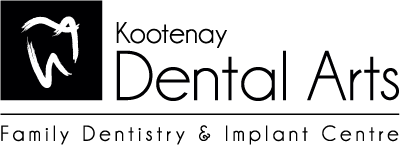Services and Treatments Offered
Our team is committed to getting to know our clients and their individual needs and expectations. Through placing an emphasis on prevention of disease and dental education, we strive to exceed your expectations and provide exceptional and comprehensive dental care. With that in mind, here is a sample of some of the treatments and services we provide (click on links for details).
Exams
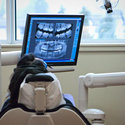 Our examinations begin with an extra-oral exam to evaluate the muscles of mastication and temporomandibular joint. We then move into the mouth to look at the oral soft tissue, the occlusion (bite), and finally the teeth. We use all of the diagnostic tools at our disposal such as radiographs including 3D scanning and intraoral cameras.
Our examinations begin with an extra-oral exam to evaluate the muscles of mastication and temporomandibular joint. We then move into the mouth to look at the oral soft tissue, the occlusion (bite), and finally the teeth. We use all of the diagnostic tools at our disposal such as radiographs including 3D scanning and intraoral cameras.
3D Scans
We have a state-of-the-art cone beam CT scanner that can give detailed 3D images of your mouth. These scans are essential for accurate and careful implant planning and also very valuable for general diagnosis and some root canal treatments.
X-Rays (Radiographs)
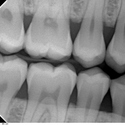 X-rays or radiographs are a necessary part of a complete dental check-up. Dentistry is one of the only branches of healthcare where radiographs are indicated in the absence of any signs or symptoms of disease. Cavities are asymptomatic up until the point when they may require extensive treatment such as a root-canal or an extraction; until they reach this point some cavities are not visible during a routine dental exam. We do, however, use digital x-rays which contain only about 10% of the radiation of traditional x-rays.
X-rays or radiographs are a necessary part of a complete dental check-up. Dentistry is one of the only branches of healthcare where radiographs are indicated in the absence of any signs or symptoms of disease. Cavities are asymptomatic up until the point when they may require extensive treatment such as a root-canal or an extraction; until they reach this point some cavities are not visible during a routine dental exam. We do, however, use digital x-rays which contain only about 10% of the radiation of traditional x-rays.
Intraoral Photographs
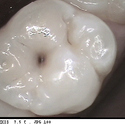 We also have the capability to take intra-oral photographs. These are useful both in patient education, and in tracking changes within the mouth.
We also have the capability to take intra-oral photographs. These are useful both in patient education, and in tracking changes within the mouth.
Cleanings (Scaling/Root Planing)
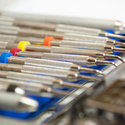 Scaling and root planing is the removal of hard calculus or tartar deposits from teeth. Once plaque had been left on the tooth for a period of time, it becomes calcified and adheres to the tooth surface. At this point no amount of brushing or flossing will remove it, and special instruments must be used. If left, gum disease may progress and lead to irreversible loss of the bone support around the teeth. For most people cleanings are recommended once every six months.
Scaling and root planing is the removal of hard calculus or tartar deposits from teeth. Once plaque had been left on the tooth for a period of time, it becomes calcified and adheres to the tooth surface. At this point no amount of brushing or flossing will remove it, and special instruments must be used. If left, gum disease may progress and lead to irreversible loss of the bone support around the teeth. For most people cleanings are recommended once every six months.
Restorations
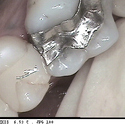 Restorations or fillings as they are commonly known do just that, they restore or replace missing, damaged or diseased tooth structure. They can also be used to reshape teeth in the absence of disease.
Restorations or fillings as they are commonly known do just that, they restore or replace missing, damaged or diseased tooth structure. They can also be used to reshape teeth in the absence of disease.
Sealants
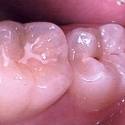 A sealant is a preventative measure that can be applied to teeth that are prone to cavities. The surface of the tooth is cleaned and then a plastic filling is place in the deep grooves of the teeth.
A sealant is a preventative measure that can be applied to teeth that are prone to cavities. The surface of the tooth is cleaned and then a plastic filling is place in the deep grooves of the teeth.
Crowns/Inlays/Onlays
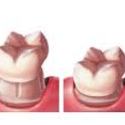 Crowns, inlays, and onlays are all lab-fabricated restorations. A crown is used to entirely cover or “cap” a damaged tooth. Besides strengthening a damaged tooth, a crown can be used to improve its appearance, shape or alignment. A crown can also be placed on top of an implant to provide a tooth-like shape and structure for function. Porcelain or ceramic crowns can be matched to the color of your natural teeth. Other materials include gold and metal alloys, acrylic and ceramic. These alloys are generally stronger than porcelain and may be recommended for back teeth. Porcelain bonded to a metal shell is often used because it is both strong and attractive.
Crowns, inlays, and onlays are all lab-fabricated restorations. A crown is used to entirely cover or “cap” a damaged tooth. Besides strengthening a damaged tooth, a crown can be used to improve its appearance, shape or alignment. A crown can also be placed on top of an implant to provide a tooth-like shape and structure for function. Porcelain or ceramic crowns can be matched to the color of your natural teeth. Other materials include gold and metal alloys, acrylic and ceramic. These alloys are generally stronger than porcelain and may be recommended for back teeth. Porcelain bonded to a metal shell is often used because it is both strong and attractive.
Veneers
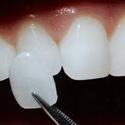 Veneers are conservative restorations that are often used to change the esthetics of teeth. With veneers you can alter the shape and colour of teeth, without removing a lot of tooth structure in the process. Essentially, thin pieces of porcelain are bonded onto the front surface of the tooth.
Veneers are conservative restorations that are often used to change the esthetics of teeth. With veneers you can alter the shape and colour of teeth, without removing a lot of tooth structure in the process. Essentially, thin pieces of porcelain are bonded onto the front surface of the tooth.
Bleaching
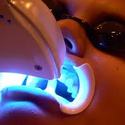 Bleaching is a method of intrinsically changing the colour of a tooth.
Bleaching is a method of intrinsically changing the colour of a tooth.
Dentures
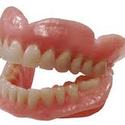 Dentures can be used to replace missing teeth. Complete dentures for people missing all of their teeth, and removable partial dentures, for people who still have some teeth remaining. They are not ideal as they can be quite bulky and cover over a significant amount of the soft tissue in the mouth. There is often quite a long adjustment period when first wearing dentures. While they are not optimal, they can be used to successfully replace missing teeth and restore some function.
Dentures can be used to replace missing teeth. Complete dentures for people missing all of their teeth, and removable partial dentures, for people who still have some teeth remaining. They are not ideal as they can be quite bulky and cover over a significant amount of the soft tissue in the mouth. There is often quite a long adjustment period when first wearing dentures. While they are not optimal, they can be used to successfully replace missing teeth and restore some function.
Bridges
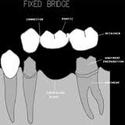 Bridges are commonly used to replace one or more missing teeth. They span the space where the teeth are missing. Bridges are cemented to the natural teeth or implants surrounding the empty space. These teeth, called abutments, serve as anchors for the bridge. A replacement tooth, called a pontic, is attached to the crowns that cover the abutments. As with crowns, you have a choice of materials for bridges. The disadvantages in having a bridge placed are that you have to crown teeth which may or may not have otherwise required crowns. Everything is connected, so you can’t floss around the teeth without threading the floss underneath the bridge, and if something happens to one of the teeth, often the whole unit is impacted. It also puts a lot of pressure on the supporting teeth as they now have to take the extra biting force of the newly replaced tooth or teeth. Also, over time, the bone where the missing tooth once was will slowly resorb, possibly resulting in a larger space beneath the bridge or limiting future restorative options.
Bridges are commonly used to replace one or more missing teeth. They span the space where the teeth are missing. Bridges are cemented to the natural teeth or implants surrounding the empty space. These teeth, called abutments, serve as anchors for the bridge. A replacement tooth, called a pontic, is attached to the crowns that cover the abutments. As with crowns, you have a choice of materials for bridges. The disadvantages in having a bridge placed are that you have to crown teeth which may or may not have otherwise required crowns. Everything is connected, so you can’t floss around the teeth without threading the floss underneath the bridge, and if something happens to one of the teeth, often the whole unit is impacted. It also puts a lot of pressure on the supporting teeth as they now have to take the extra biting force of the newly replaced tooth or teeth. Also, over time, the bone where the missing tooth once was will slowly resorb, possibly resulting in a larger space beneath the bridge or limiting future restorative options.
Implants
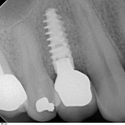 Implants are currently the best option for replacing missing teeth. Essentially, a titanium implant is placed in the bone where the tooth’s root used to sit and a crown is placed on top of the implant. Unlike a denture it isn’t bulky and is fixed in place. Unlike a bridge it doesn’t affect the neighboring teeth and replaces both the crown and root of the tooth helping to maintain bone in the area. Implants aren’t just limited to single teeth they can also be used to replacing multiple teeth or for stabilizing dentures.
Implants are currently the best option for replacing missing teeth. Essentially, a titanium implant is placed in the bone where the tooth’s root used to sit and a crown is placed on top of the implant. Unlike a denture it isn’t bulky and is fixed in place. Unlike a bridge it doesn’t affect the neighboring teeth and replaces both the crown and root of the tooth helping to maintain bone in the area. Implants aren’t just limited to single teeth they can also be used to replacing multiple teeth or for stabilizing dentures.
Tooth Extractions
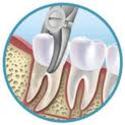 Sometimes it is necessary to extract teeth. This is often a last resort when the tooth is lacking supporting tissue, or if the tooth is very heavily restored, cracked or infected. Sometimes teeth can be extracted electively to create space, or sometimes teeth that haven’t erupted properly, or are impacted, are extracted, as well.
Sometimes it is necessary to extract teeth. This is often a last resort when the tooth is lacking supporting tissue, or if the tooth is very heavily restored, cracked or infected. Sometimes teeth can be extracted electively to create space, or sometimes teeth that haven’t erupted properly, or are impacted, are extracted, as well.
Root Canals
 A root canal is indicated when the soft tissue inside the tooth, or pulp, is either inflamed to the point where it is unable to heal itself (often due to infection), or when that tissue is actually necrotic, or dead. The procedure involves removing this dead, inflamed or infected tissue and placing a filling down into the roots of the tooth filling the void where that tissue used to reside. Once a root canal treatment has been performed, it is beneficial to follow-up with a crown to best seal the tooth and prevent the weakened tooth from fracturing or re-infecting.
A root canal is indicated when the soft tissue inside the tooth, or pulp, is either inflamed to the point where it is unable to heal itself (often due to infection), or when that tissue is actually necrotic, or dead. The procedure involves removing this dead, inflamed or infected tissue and placing a filling down into the roots of the tooth filling the void where that tissue used to reside. Once a root canal treatment has been performed, it is beneficial to follow-up with a crown to best seal the tooth and prevent the weakened tooth from fracturing or re-infecting.
Periodontal (Gum) Surgery
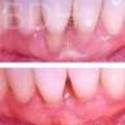 The purpose of periodontal surgery is to treat deformities and tissue loss created by the disease process. This is accomplished by eliminating “pockets” of diseased tissue; regenerating and reconstructing gum and periodontal tissue attachment to the teeth and generally to provide an environment more conducive to daily oral hygiene and professional maintenance care.
The purpose of periodontal surgery is to treat deformities and tissue loss created by the disease process. This is accomplished by eliminating “pockets” of diseased tissue; regenerating and reconstructing gum and periodontal tissue attachment to the teeth and generally to provide an environment more conducive to daily oral hygiene and professional maintenance care.
Pediatric (Children’s) Dentistry
 Pediatric dentistry involves the treatment of children’s teeth. Primary or baby teeth are important as they hold the space for the adult teeth and can get cavities or infections, just as adult teeth can. They can be difficult to treat, as the teeth are small; so cavities tend to progress rapidly. We recommend a first visit to the dentist at around three years old. It is a valuable time as the posterior primary teeth are beginning to erupt and it is a good time to get children comfortable with the environment of a dental office. It is also a great time to speak with the parents about the care of their children’s teeth and answer any questions that they may have.
Pediatric dentistry involves the treatment of children’s teeth. Primary or baby teeth are important as they hold the space for the adult teeth and can get cavities or infections, just as adult teeth can. They can be difficult to treat, as the teeth are small; so cavities tend to progress rapidly. We recommend a first visit to the dentist at around three years old. It is a valuable time as the posterior primary teeth are beginning to erupt and it is a good time to get children comfortable with the environment of a dental office. It is also a great time to speak with the parents about the care of their children’s teeth and answer any questions that they may have.
Geriatric Dentistry
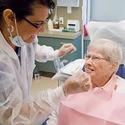 Geriatric dentistry is dentistry for elderly patients. More and more these days, people are maintaining their natural dentition until very late in life. As people get older and their cognitive function and dexterity decrease, proper hygiene and maintenance can be difficult. This population of people also has a higher incidence of conditions which can affect the dentition, such as type II diabetes and xerostomia (dry mouth). Due to this, oftentimes extra preventative measures, such as prescription strength toothpastes or saliva substitutes, are indicated.
Geriatric dentistry is dentistry for elderly patients. More and more these days, people are maintaining their natural dentition until very late in life. As people get older and their cognitive function and dexterity decrease, proper hygiene and maintenance can be difficult. This population of people also has a higher incidence of conditions which can affect the dentition, such as type II diabetes and xerostomia (dry mouth). Due to this, oftentimes extra preventative measures, such as prescription strength toothpastes or saliva substitutes, are indicated.
Occlusal (Bite) Adjustment & Equilibration
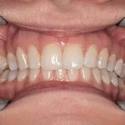 The bite is not a simple two-dimensional motion of teeth opening and closing on one another. With the lower jaw able to move side-to-side and front-to-back, it is actually a complex three-dimensional system. During some of these sideways motions, or excursions, unfavourable parts of the tooth may come in contact and lead to soreness in the teeth or jaw, as well as irregular wear patterns or chipping of the teeth. Sometimes, in relatively straightforward cases, these interferences can be adjusted and the bite equilibrated.
The bite is not a simple two-dimensional motion of teeth opening and closing on one another. With the lower jaw able to move side-to-side and front-to-back, it is actually a complex three-dimensional system. During some of these sideways motions, or excursions, unfavourable parts of the tooth may come in contact and lead to soreness in the teeth or jaw, as well as irregular wear patterns or chipping of the teeth. Sometimes, in relatively straightforward cases, these interferences can be adjusted and the bite equilibrated.
Temperomandibular Joint (Jaw Joint/’TMJ’) Treatment
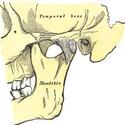 The temporomandibular joint is the joint connecting your mandible (lower jaw) with the base of the skull. Sometimes people can have problems with the function of this joint and these problems can usually be separated into a couple of categories. These would be muscular problems or problems involving the bone/cartilage. Sometimes people can even have a combination of both. Treatment protocols can vary and often include behavior/habit modification, wearing a specially designed mouthguard as you sleep, physio- or massage-therapy, and in severe cases, even surgery.
The temporomandibular joint is the joint connecting your mandible (lower jaw) with the base of the skull. Sometimes people can have problems with the function of this joint and these problems can usually be separated into a couple of categories. These would be muscular problems or problems involving the bone/cartilage. Sometimes people can even have a combination of both. Treatment protocols can vary and often include behavior/habit modification, wearing a specially designed mouthguard as you sleep, physio- or massage-therapy, and in severe cases, even surgery.
Sedation
 Sometimes patients, especially for longer or more involved procedures, will opt to take a sedative. There are several different options for oral sedatives, and these can be discussed with the dentist. While they won’t do anything for pain (you will still have to receive local anesthesia/freezing), they can make patients more relaxed and some even have some amnesic properties, causing you to partially forget the experience afterward.
Sometimes patients, especially for longer or more involved procedures, will opt to take a sedative. There are several different options for oral sedatives, and these can be discussed with the dentist. While they won’t do anything for pain (you will still have to receive local anesthesia/freezing), they can make patients more relaxed and some even have some amnesic properties, causing you to partially forget the experience afterward.
Sport Mouthguards
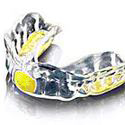 Custom-made sports mouthguards can be fabricated for you at a dental lab. They have several advantages in comparison to over-the-counter guards. They are much thinner, while still maintaining strength, and also are custom-fit to your mouth.
Custom-made sports mouthguards can be fabricated for you at a dental lab. They have several advantages in comparison to over-the-counter guards. They are much thinner, while still maintaining strength, and also are custom-fit to your mouth.
